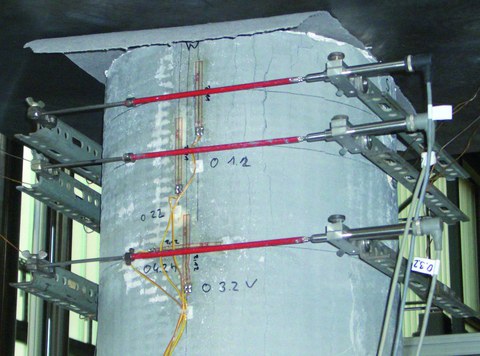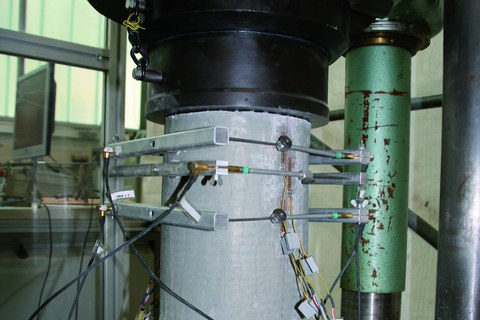SFB 528-D4: Verstärkung von normalkraft- und torsionsbeanspruchten Bauteilen mit TRC
Inhaltsverzeichnis
Projektdaten
|
Titel | Title |
Kurzbeschreibung
Ziele dieses Teilprojektes sind die Erhöhung der Verstärkungswirkung für Bauteile unter Normalkraftbelastung sowie die Untersuchung der Verstärkungswirkung für torsionsbelastete Bauteile. Großversuche sollen zudem den Nachweis der Anwendbarkeit der im gesamten SFB entwickelten Berechnungsansätze zeigen. Die Tragfähigkeitserhöhung bei Normalkraft belasteten Stützen beruht zum einen auf dem zusätzlichen Betonmantel und zum anderen auf der Umschnürungswirkung der textilen Bewehrung. Die Verstärkung bewirkt zudem eine außerordentliche Erhöhung der Duktilität. Durch die Möglichkeit, die textile Bewehrung parallel zur Zugkraft auszurichten (hier im Winkel von ca. 45°) wird bei einer Torsionsverstärkung neben der Erhöhung der Tragfähigkeit, eine deutliche Erhöhung der Steifigkeit und damit auch der Gebrauchstauglichkeit erreicht. Anhand von Großversuchen an Stahlbetonplatten und Stahlbetonstützen konnte die Anwendbarkeit der im Vorfeld entwickelten Biegebemessungsmodelle sowie des Umschnürungsmodells auch für Bauteile mit realen Abmessungen nachgewiesen werden.
Link zur Webseite
Bericht aus dem Jahrbuch 2010
Stützenverstärkung mit Textilbeton

Verformungsmessung am Stützenkopf
Untersuchungen an Stützenköpfen unterschiedlicher Geometrie haben gezeigt, dass mit textilbewehrtem Beton (TRC) eine beachtliche Verstärkungswirkung erzielt werden kann. Die Tragfähigkeitserhöhung beruht zu einem Teil auf dem zusätzlichen Betonmantel. Zum anderen wird sie aber entscheidend durch die Umschnürungswirkung der textilen Bewehrung bewirkt, was insbesondere im Lasteinleitungsbereich von Stützen von großer Bedeutung ist. Die Umschnürung erzeugt einen dreiaxialen Spannungszustand im Betonkern und sorgt damit für eine Traglasterhöhung der gesamten Stütze.
Die Gültigkeit des neu entwickelten Rechenmodells sollte nun in Großversuchen überprüft werden, da es anhand kleinteiliger Tests entwickelt worden war. Die Vorhersagegenauigkeit wurde anhand von drei Stahlbetonstützen mit rundem Querschnitt experimentell untersucht. Die Stützen waren 2 m hoch und hatten einem Durchmesser von 30 cm. Eine Stütze blieb unverstärkt und diente als Referenz. Zwei weitere Stützen wurden über die gesamte Höhe mit 5lagig bewehrtem TRC verstärkt, wobei eine der beiden Stützen am Stützenkopf und am Stützenfuß noch zusätzlich verstärkt wurde.
Die Tragfähigkeit der mit Textilbeton verstärkten Stützen nahm im Vergleich zur Referenzstütze um fast 100 % zu. Diese Versuche haben außerdem bewiesen, dass die erreichten Traglasten mit dem entwickelten Umschnürungsmodell sehr gut vorhergesagt worden sind. Vom Normalkraftanteil des Feinbetons ist im Wesentlichen die erzielbare Traglaststeigerung bis zum Versagen des Stützenkerns abhängig. Nach diesem Kernversagen kommt es vermutlich infolge der zunehmenden Querdehnungen zur Ausbildung eines Reibverbundes zwischen Feinbetonschicht und Kernbeton. Somit wird der umschnürte Teil der Feinbetonhülle erneut aktiviert und es können weitere Längskräfte über die textile Verstärkungsschicht abgetragen werden. Dieser Mechanismus trägt zusätzlich zur Umschnürung des Kernbetons zur Traglaststeigerung bei.
Neben einer Steigerung der Tragfähigkeit ergab sich durch die textilbewehrte Verstärkung aber auch eine deutliche Verbesserung des Vorankündigungsverhaltens. Im Laufe der Laststeigerung bildeten sich zunächst feine und später deutlich sichtbare, gleichmäßige Risse. Im weiteren Verlauf der Lasterhöhung wurde die Annäherung an die Bruchlast durch Abplatzungen der Betondeckung unmittelbar sichtbar. Insgesamt wurde eine große Duktilität der verstärkten Stützen erreicht.
Bericht aus dem Jahrbuch 2009
Normalkraft- und Torsionsverstärkung

Probekörper in einer Druckprüfmaschine
Nachdem bereits die Untersuchungen zur Biege- und Querkraftverstärkung mit Textilbeton deutliche Verbesserungen des Tragverhaltens gezeigt haben, werden im Moment die Normalkraft- und Torsionsverstärkung erforscht und im Folgenden die aktuellen Untersuchungen und Ergebnisse vorgestellt.
Zur Zeit durchgeführte Studien umfassen quadratische und runde Stahlbetonquerschnitte. Die im Labor hergestellten Probekörper werden nach dem Aufrauen der Oberfläche vorgenässt und anschließend mit Textilbeton verstärkt. Neben verschiedenen Bewehrungsmaterialien (alkaliresistentem Glas bzw. Carbon) und unterschiedlichen Bewehrungsgraden (1-6 Lagen textile Bewehrung) werden auch die Einflüsse unterschiedlicher Eckausrundungen am Altbetonprobekörper betrachtet. Bei den auf Torsion belasteten Probekörpern wird die textile Bewehrung in dem für Torsion bevorzugten Winkel von 45° angeordnet.
Für die Belastungsversuche werden Druckprüfmaschinen sowie ein eigens entwickelter Torsionsprüfstand genutzt. Die Messung der belastungsabhängigen Verformung während des Versuches erfolgt mit Dehnmessstreifen, induktiven Wegaufnehmern und photogrammetrischen Messverfahren.
Normalkraftverstärkung. Die Traglaststeigerung ergibt sich aus der Querschnittserhöhung infolge der zusätzlich aufgebrachten Betonschicht und aus einer Umschnürungswirkung der textilen Bewehrung. Ergebnisse der Untersuchungen an runden Stützen belegen eine deutliche Umschnürungswirkung. Bei den eckigen Stützen wird eine Zunahme der Umschnürungswirkung mit zunehmenden Eckausrundungsradien sichtbar. Des Weiteren wird die Umschnürungswirkung mit zunehmendem Bewehrungsgrad erhöht. Die Umschnürung erzeugt einen dreiaxialen Spannungszustand im Betonkern der Stütze und führt somit zu einer deutlichen Steigerung der Tragfähigkeit.
Torsionsverstärkung. Durch die Möglichkeit, die textile Bewehrung parallel zur Zugkraft auszurichten (hier im Winkel von ca. 45°), wird neben der Erhöhung der Tragfähigkeit eine deutliche Erhöhung der Steifigkeit und damit auch der Gebrauchstauglichkeit erreicht. Mit zunehmendem Bewehrungsgrad vergrößern sich die Tragfähigkeit und die Steifigkeit. Die Querschnittsvergrößerung trägt weiterhin dazu bei, dass auch die Tragfähigkeit der Druckstrebe erhöht wird. Bei den untersuchten Probekörpern konnte die Tragfähigkeit bis um das Dreifache erhöht werden. Durch die Textilbetonverstärkung wurde eine deutliche Verringerung der Rissbreiten und Rissabstände realisiert, was sich ebenfalls sehr positiv auf die Gebrauchstauglichkeit auswirkt.
